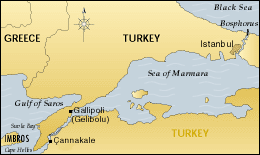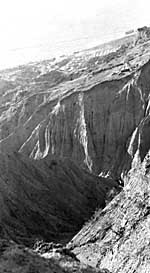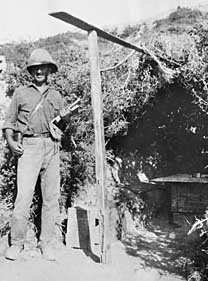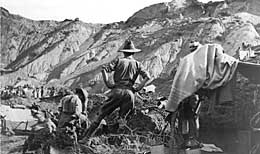|
|
 |
 |

  



The strategic significance of the
Dardanelles

 |
 |
 |

The initial landings on 25 April 1915 on Gallipoli by
British Empire forces and French forces failed. It had been
intended on that day for the Australians to seize the main
heights of the Sari Bair Range from Kabatepe in the south to
Hill 971–Kocacimentepe–in the north. Landing after the 1st
Australian Division, the New Zealand Infantry Brigade were to
push eastwards across the range to Maltepe, a hill overlooking
the straits of the Dardanelles. British forces, landing at the
tip of the peninsula around Cape Helles, were to push north as
far as a hill called Alcitepe (known to the British as Achi
Baba). From these initial positions, the British and the
Australians and New Zealanders–the ‘Anzacs’ –would then
advance to the north east and south east in a pincer movement
to capture the whole of the southern Gallipoli peninsula. This
would silence the Turkish defences on the western shore at the
narrowest part of the Dardanelles–the Narrows–and permit ships
of the Royal Navy through to threaten the Turkish capital,
Constantinople (now Istanbul). However, on 25 April, on the
Gallipoli peninsula, the British and the Anzacs were only able
to seize a small portion of Cape Helles and a few square
kilometres inland of where the Australians and New Zealanders
had landed. For the rest of the campaign these areas were
known respectively as ‘Helles’ and ‘Anzac’. For three days the
Anzacs fought desperately to avoid being thrown back into the
sea by the Turks. |
 |


  



Steep ground at the head of
Mule Gully and
Walker's Ridge.
(AWM G00914)

 |
 |

As everywhere along the line during those days, the
enemy assault at Walker’s Ridge above North Beach on the left
flank of the Anzac position was fierce. Lieutenant Ivor
Margetts recalled the attacks of the Turkish soldiers:
 |

On Tuesday [27 April] the Turks made a
very determined attack against our left flank and we
were standing to arms all day with bayonets fixed
awaiting the charge which never came. At night the Turks
did everything imaginable to raise their courage,
blowing bugles, shouting "Allah" and shooting like Hell.
We naturally expected every minute to be called upon to
get to work with the bayonet. Every few minutes the cry
rang out "Supports ready to charge" and up we rush,
revolvers drawn and bayonets gleaming in the moonlight
and one continuous rattle of musketry and machine guns.
It was a nerve-wracking night, the tension broken every
now and then by the orders "Stretcher-bearers wanted on
the right or left" or "Another machine gun wanted". But
the longest night must come to an end and every man
seemed to heave a sigh of relief when the grey dawn
spread over the sky and showed us that, although by a
hot fire we had held our position, the still forms of
Australia’s manhood and the stream of stretchers making
towards the clearing hospital on the beach, our name had
been made with heavy casualties. |
 |
 |

[Captain I S Margetts, Diary,
27 April 1915,
AWM 1 DRL/0478] |
 | |
 |


  



Colonel Arthur Bauchop,Commanding
Officer, Otago
Mounted Rifles, New Zealand
Expeditionary Force, in front
of his
hut, near No 2 Outpost. Bauchop's hut
was partly
constructed using oars from
the boats of the 7th Battalion,
AIF, which
were stranded near the site of the outpost
on
25 April 1915, many of their occupants
having been killed
during the landing.
Colonel Bauchop was wounded on 7
August
1915 in the August offensive and he died
of his
wounds the next day. He is
commemorated on the Lone
Pine
memorial to the missing.
(AWM
A01829)

 |
 |

On 26 May, as part of the general development of their
positions in the ranges north of Anzac, the Turks secretly set
up their own outpost in the foothills leading to No 2 Outpost.
The New Zealand Mounted Rifles, who were now garrisoning the
two outposts, instantly took up this challenge to their
previous dominance of the area and attacked the position,
taking it from the Turks. Over the following days, sharp
engagements ensued as the enemy fought hard to regain the
post. Sergeant John Wilder of the Wellington East Coast
Squadron recalled the intensity of the fighting:
 |

It was regular hell for 24 hours that we were
there, we hardly had a moment’s peace. We were
absolutely surrounded by Turks who were just beneath us
under the cliff with covering fire on the other side of
the gully. The Turks were almost close enough to touch,
but the covering fire kept us down and they just threw
in bombs as they liked. The only thing to do was to pick
them up and throw them back at the enemy. |
 |
 |

[Wilder, quoted in C Pugsley,
Gallipoli –
The New Zealand Story,
London, 1984,
p.233] |
 | 
Eventually, despite the determined resistance of the
New Zealanders, the Turks regained their trench and the New
Zealanders retreated to No 2 Outpost, having lost 26 killed
and 65 wounded. |
 |


  



Men of the 1st Light Horse Regiment taking over
new
dugouts near No 1 Outpost, below the rugged spurs
of
the Sari Bair Range.
(AWM C02727)

 |
 |

So fierce had been the fighting for this small piece
of the Anzac line that it had drawn in virtually the whole
brigade of the New Zealand Mounted Rifles. The incident
impressed one of the Turkish commanders–Colonel Mustafa Kemal.
Kemal reasoned that if he could send a whole regiment down the
rugged spurs from the heights to contest ground with the
Anzacs, then they could just as easily send men up from the
beaches to contest Turkish mastery of the Sari Bair
Range.

The story of these small outposts at the end of North
Beach where it runs into Ocean Beach is a little known story
of Anzac. But men suffered and died there as much as at any
better known part of the line. Something of the sacrifice of
the New Zealand Mounted Rifles in this area can be seen in a
small cemetery–Canterbury Cemetery–which, as the cemetery
register states, is ‘one of the central cemeteries of Anzac’.
Those buried here were brought in after the war from isolated
grave sites dotted throughout this area and 20 of the 26 men
buried in this small cemetery fought with the New Zealand
Mounted Rifles. 
|
 |

 | | |
|